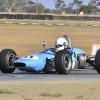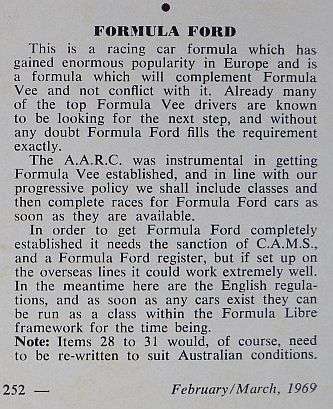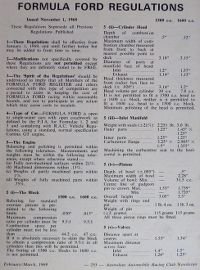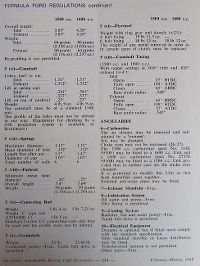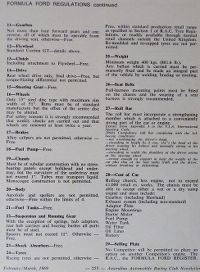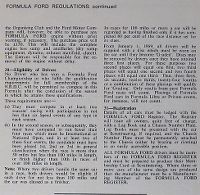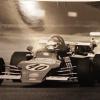
ANF Formulae of the sixties
#1

Posted 03 July 2007 - 07:44
I have been fed what I've written below & would like to know it's accuracy.
My particular interest is 1967,68,69
1964
ANF2 was ex FJ cars of 1100cc push rod engine
ANF1500 (A 1 ½ F) 1500cc
FIA F3 Restricted 1000cc
FIA F2 Unrestricted 1000cc
1966
ANF3 Incl. FIA F3 1000cc
ANF2 Incl. FIA F2 1100cc
ANF1 ½ ex ANF 1500 1500cc
1969
ANF3 1100cc
ANF2 1600cc
1971
ANF2 2000cc
1972
ANF3 1300cc
Advertisement
#2

Posted 03 July 2007 - 13:10
In 1964 the Tasman Formula was introduced as ANF1 with 2.5-litre free design race engines running on Avgas. ANF1½ was introduced to give a category to the growing number of 1.5-litre cars being built here and arriving from overseas. ANF2 was virtually an extension of FJunior, but it may not have had the minimum weight limit (probably because there were no scales anywhere).
Around 1968 there was a shuffling with ANF2 becoming the name of the secondary formula and ANF3 taking over the 1100cc category. At no time was the latter for 'free design' engines, it was always for engines from 'CAMS recognised' production cars.
This change brought the FVA engine into ANF2, which wasn't desirable for a couple of reasons. On the one hand, these cars were essentially competitive with the ANF1 cars and miles in front of the regular (read 'Lotus Ford Twin Cam) ANF2 cars. A new rule restricting ANF2 to two valves per cylinder came in at some time, probably 1969.
F5000 became ANF1 next, with 2000cc free design engines eligible for a couple of years.
Just which year saw the change of the ANF3 category to 1300cc I'm unsure of. It was probably 1971. The Clubman formula changed at the same time.
Things remained static until 1978, when the single cam 1600cc (production based) ANF2 took the place of both ANF2 and ANF3.
#3

Posted 04 July 2007 - 00:06
That makes sense. Kind of!
It does really.... but I can see (from stories that I've heard & what you clarified) why people got annoyed from the continuous rule changes from year to year.
Correct me if I'm wrong but to me there seems to be a disproportionate amount of 1.5L cars log booked & running around today than there really was during that time when most were actually 1.1L (I'm talking groups M & O)
Would this be a case of chassis design was say 67 but the car ran an 1.5l engine in 71 so lets leave in, in it's 71 config but historically log book it as 67?
I have no idea hence the question.
#4

Posted 04 July 2007 - 05:04
You said it , i didn't. You had better address your questions to your local CAMS eligibility officials & the Historic Commission......Originally posted by giffo
Thanks Ray
That makes sense. Kind of!
It does really.... but I can see (from stories that I've heard & what you clarified) why people got annoyed from the continuous rule changes from year to year.
Correct me if I'm wrong but to me there seems to be a disproportionate amount of 1.5L cars log booked & running around today than there really was during that time when most were actually 1.1L (I'm talking groups M & O)
Would this be a case of chassis design was say 67 but the car ran an 1.5l engine in 71 so lets leave in, in it's 71 config but historically log book it as 67?
I have no idea hence the question.
#5

Posted 05 July 2007 - 09:52
1.1s were thin on the ground, except for uncompetitive cars.
#6

Posted 26 September 2010 - 03:38
Just which year saw the change of the ANF3 category to 1300cc I'm unsure of. It was probably 1971. The Clubman formula changed at the same time.
Things remained static until 1978, when the single cam 1600cc (production based) ANF2 took the place of both ANF2 and ANF3.
Giffo was thinking ANF3 could have commenced in 1972.
I presume the Corolla engine became a mainstay.
It seems from the Elfin register that their type 623s didn't really hit the tracks til 1973 (nothing unusual in that), but am wondering what entrants were driving in the early days of ANF3 and whether it was 1971,2 or 3?
James
#7

Posted 26 September 2010 - 05:21
Around 1968 there was a shuffling with ANF2 becoming the name of the secondary formula and ANF3 taking over the 1100cc category. At no time was the latter for 'free design' engines, it was always for engines from 'CAMS recognised' production cars.
This change brought the FVA engine into ANF2, which wasn't desirable for a couple of reasons. On the one hand, these cars were essentially competitive with the ANF1 cars and miles in front of the regular (read 'Lotus Ford Twin Cam) ANF2 cars. A new rule restricting ANF2 to two valves per cylinder came in at some time, probably 1969.
Things remained static until 1978, when the single cam 1600cc (production based) ANF2 took the place of both ANF2 and ANF3.
So, presumeably, for FVAs to be legal (when 4 valves were allowed), some time late in the sixties when these changes came about, ANF2 wouild have snuck up to 1600cc as well, or, FVA cubic capacity for racing in Oz got reduced to 1500cc?
Or, were the bigger than 1500cc Lotus Ford Twin Cams etc, that were running before and after the change that brought in the FVA, running in ANF1? From race results in 1968 I think that I've answered my own question in that it seems that FVAs in 1968 being run by Niel Allen (McLAren M4A), Glyn Scott (Bowin P3) and Peter Macrow (McLaren M4A) were all entered in various races as ANF1 cars. Those who were running Lotus Fords must have reduced their capacities to 1500. It looks like the same entry lists/race results have 1100cc cars listed as ANF3 at that stage.
One does see the odd open wheeler from that period sporting a Lotus Ford Twin Cam with a tall block these days......
James
#8

Posted 26 September 2010 - 18:37
Nobody ran the tall blocks in the day.
I'm not able at the moment to properly check things out to get dates more clearly settled. This may well have been the case when I made the previous posts, too, as I used to spend a lot of time on the road.
#9

Posted 26 September 2010 - 21:52
Edited by David Shaw, 26 September 2010 - 21:53.
#10

Posted 26 September 2010 - 23:37
I have the FVAs and Waggott TC/4Vs running in ANF2 in 1969, and an unofficial class '1600-2v' for the Twin Cams, and ANF3 for the 1100s. Same for 1970 in the Gold Star at least.
Is it any wonder the National Formula eventually failed? Given that the historians here are still somewhat confused after 40 odd years spare a thought for the poor buggers back in the day who were racing (any of the periods). In reality due tho the mix at most tracks it must have been near always Formula Libra. You could argue that only FVee & FFord got the consistancy of rules right.
One thing that has never changed tho is he with the most money & best gear stood the best chance of winning provided they had an ounce of ability behind the wheel.
#11

Posted 27 September 2010 - 00:28
Is it any wonder the National Formula eventually failed? Given that the historians here are still somewhat confused after 40 odd years spare a thought for the poor buggers back in the day who were racing (any of the periods). In reality due tho the mix at most tracks it must have been near always Formula Libra. You could argue that only FVee & FFord got the consistancy of rules right.
One thing that has never changed tho is he with the most money & best gear stood the best chance of winning provided they had an ounce of ability behind the wheel.
I think it was actually pretty well understood at the time and the changes mostly followed a logic dictated by changing circumstances. At this distance in time its somtimes difficult to understand those changes when we often no longer recognise the changing circumstances leading to them. FVee was, of course, there thoughout this period and the arrival of Formula Ford in 1969/70 eventually lead to the major rationalisation in formulae we saw in the mid 70's.
The Australian National Formulae from 1968 were as follows :
1968
ANF1 2.5 litres 'Tasman' Formula
ANF 1.5 - 1500cc 4 cylinder engines
ANF2 - 1100cc production based engines
ANF3 - 1000cc single carburetted restricted production engines aligned to FIA F3 but little used in Australia.
1969
ANF1 was unchanged
ANF2 went to 1600cc 4 cylinder engines (including the FVA) and ANF1.5 disappeared
ANF3 was essentially what had been ANF2 and replaced the previous unused ANF3 when FIA F3 went to 1600cc
1970
no change
1971
ANF1 allowed 2000cc free design unsupercharged engines or F5000 V8s
ANF2 was restricted to 4 cylinder 1600cc 2 valve per cylinder engines
ANF3 was unchanged but went to 1300cc in 1972.
#12

Posted 27 September 2010 - 05:23
I for one have always been confused about 1968 - and now I can see why
#13

Posted 28 September 2010 - 01:51
Originally posted by Paul Hamilton
I think it was actually pretty well understood at the time and the changes mostly followed a logic dictated by changing circumstances. At this distance in time its somtimes difficult to understand those changes when we often no longer recognise the changing circumstances leading to them.....
Paul makes a very good point here...
There was always Formula Libre racing here and there was always a 'big car' and 'small car' mix, typically with a lot of MGs in the 'small cars' during the fifties.
There was, by 1961 or so, a large swing of opinion towards the ideal that we either adopt some International formulae or create our own. Those with a better idea of costs saw that International formulae would be horrendously expensive on this side of the world and eventually subdued those who held those ideals.
In the interim, just two occasions saw such formulae adopted. In the very early fifties (1951?) a move to have F1 and F2 as our classes saw one race meeting only, at Woodside, held to these rules. The Maybach lost its supercharger because of this being mooted and never regained it, but that was the sum total of the impact.
The second was the adoption of International Formula Junior in 1961 (I believe), but even then there were a couple of dispensations to help local owners. FJr was to run here successfully until, as I recall, 1963.
In 1964, and possibly because of the adoption of the Tasman formula, it became obvious that we had to have a structured set of racing classes for our openwheelers.
So we adopted:
ANF1 - 2.5-litre free design engines unsupercharged running on Avgas*
ANF1½ - 1.5 litres free design engines up to 4 cylinders unsupercharged running on Avgas* ++
ANF2 - 1100cc min weight production based engines as defined in FJr previously running on Avgas* ##
ANF3 - International 1000cc F3
* Actually 'Commercial fuel as defined by CAMS', but essentially 100/130 Avgas IIRC
++ Originally titled 'Australian 1½ litre Formula' by the CAMS
## Also to include International 1000cc F2 cars of four or fewer cylinders
Not that through the two lesser (ANF2 and ANF3) categories the CAMS are still trying to introduce International Formulae.
Paul has summarised the situation as times changed, but not the introduction of Formula Ford. This was a competitor-driven move but quickly received the backing of the AARC (Geoff Sykes and Warwick Farm) with a complete printing in the AARC Newsletter of Feb/Mar 1969 of the British FFord regulations and the suggestion that a FF Register should be set up and that the CAMS should adopt the formula with changes only to things like chassis pricing and engine buy-backs etc.
The Formula was introduced in the CAMS Manual in 1970.
1972, as Paul noted, saw ANF3 go to 1300cc, the Clubman formula did at the same time.
Edited by Ray Bell, 28 September 2010 - 02:11.
#14

Posted 28 September 2010 - 04:24
Cheers to both Paul & Ray
As for FF tell me please
Pre 1970 they had to have any 1600 block (the tall one) that wasn't a 711M & post 1970 the 711M one (correct?)
Also at what year did the rules change to allow the inclusion on non Australian built cars?
#15

Posted 28 September 2010 - 06:22
Originally posted by giffo
.....As for FF tell me please
Pre 1970 they had to have any 1600 block (the tall one) that wasn't a 711M & post 1970 the 711M one (correct?).....
All that is mentioned is the '1600cc Cortina GT' engine in '70 and '71. The '1600cc Capri GT' engine is listed as well in '72. No '711M' designation mentioned anywhere.
.....Also at what year did the rules change to allow the inclusion on non-Australian built cars?
Good point...
The '72 CAMS Manual is the first one that doesn't have the 'Australian manufacture' provision. The regulated price, by the way, increased year by year, and it was also allowed that non-tubular construction (ie. monocoques) could be used if they'd been built before 1968.
Edited by Ray Bell, 28 September 2010 - 07:04.
#16

Posted 28 September 2010 - 07:45
Apparently there are a few casting differences inc lifter sizing of which the older lifters are a little more than 25% lighter than the later 711m ones (I checked one time) but thats a whole other topic.
#17

Posted 28 September 2010 - 12:04
$2000 incl open trailer. Pretty competitive price as Jeff Thompson of Brisbane had a Lotus 20B with Holbay 1100cc for sale at the same money.
At the time you could also buy George Reynolds Vee for $1750 and Neil Allen's Elfin Traco for $8900. Touring car wise you get Ron Gillard's 1100 Cooper S Improved Prod car for $2500.
#18

Posted 29 September 2010 - 00:19
Yes I have that add from the April6 9 RCN infact the whole magazine. ANF3 was correct at the time in 69 (read above). The block is a 2737E casting.
As for price comparisons it always makes good reading
I bet the gear box would go for a fair bit these days?
Advertisement
#20

Posted 29 September 2010 - 21:55
G'day mate
Yes I have that add from the April6 9 RCN infact the whole magazine. ANF3 was correct at the time in 69 (read above). The block is a 2737E casting.
As for price comparisons it always makes good reading
I bet the gear box would go for a fair bit these days?
I bought an Elfin Mono from Bob Minogue in 1971/2 for $3,100.00 (trailer included), it was Victorian F3 winner and lap record holder at quite a few circuits in Bob's hands. Sold in late 1973 for $1,500.00 (with blown up engine). Was offered back to me last week for "around $35,000 needing quite a bit of work" with a twin cam engine. Unfortunately my budget doesn't run to that sort of money but I understand that there were a couple of takers haggling over buying it! When I bought it it had a 1100 Ford none crossflow with steel crank (made by Ivan Tighe I believe) twin cam rods and 85mm pistons etc. When the F3 rules changed I built a 1300 crossflow Ford engine, nitrided crank possibly standard rods and special pistons (which eventually blew up). The 1100 steel crank was left lying around at Motorlab (garage, tuning establishment who used to sponser me), when I went overseas for a few years. Not sure what happened to the crank but it isn't there any more! This car had a VW box (not Hewland) and one of the reasons for price drop (not just the blown engine) was that it still had old treaded Firestone tyres and it was a bit hard to find appropriate slicks to get the right gearing with that box as and the ride height problems with the newer lower profile tyres.
#21

Posted 06 May 2019 - 02:57
Edited by SJ Lambert, 06 May 2019 - 04:00.
#22

Posted 06 May 2019 - 11:25
Up to 2.5-litres was ANF1. Anything could run as 'Formula Libre', which also enabled cars to run superchargers and funny fuel.
ANF1 and ANF1½, as explained above, must run on 100/130 Avgas, so simply changing jets and refilling the tank with jungle juice put the car into Formula Libre.



